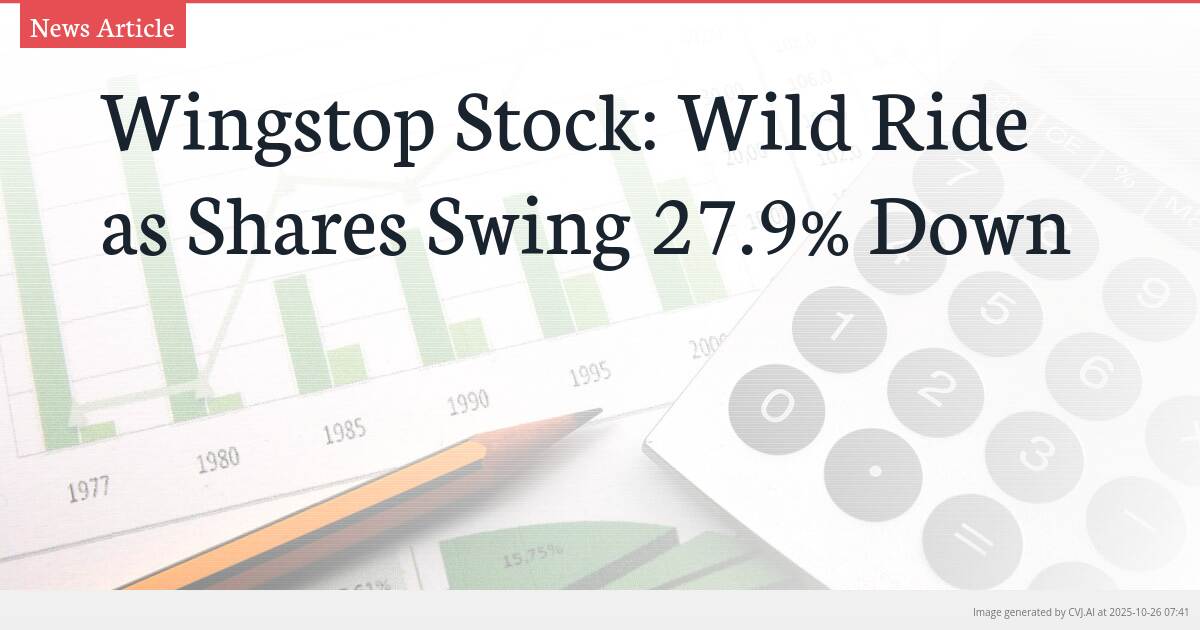This summary text is fully AI-generated and may therefore contain errors or be incomplete.
Introduction
Wingstop’s stock has experienced dramatic price swings, leaving investors questioning whether to buy shares or just stick with the wings. The restaurant chain’s shares climbed 4.7% in the past month but have fallen 27.9% over the past year. These significant movements reflect shifting market views on growth prospects and risk assessment in the competitive United States restaurant sector.
Key Points
- Stock gained 4.7% in past month but dropped 27.9% over past year
- Extreme volatility reflects changing market views on growth and risk
- Analysts focused on company's strategic doubling down on key initiatives
The Volatility Paradox: Recent Gains Amid Annual Decline
Wingstop’s stock performance presents investors with a complex puzzle of conflicting signals. The 4.7% gain over the past month suggests potential momentum building for the restaurant chain, yet this short-term uptick stands in stark contrast to the 27.9% decline witnessed over the past twelve months. This divergence creates a challenging environment for market participants trying to determine whether the recent positive movement represents a genuine turnaround or merely a temporary bounce in an otherwise downward trend.
The extreme volatility in WING shares highlights the broader uncertainty surrounding restaurant stocks in the current market environment. Such dramatic price swings—spanning from significant monthly gains to substantial annual losses—typically indicate that investors are grappling with mixed signals about the company’s fundamental health and future prospects. This pattern of conflicting performance metrics often emerges when market participants weigh short-term operational successes against longer-term strategic concerns.
Market Perception Shifts: Growth Versus Risk Assessment
The dramatic price movements in Wingstop stock reflect evolving market perceptions about growth potential versus risk exposure. When a stock demonstrates such extreme volatility, it typically signals that investors are reassessing their valuation models and risk tolerance levels. The 27.9% annual decline suggests that market participants have grown more cautious about the company’s ability to maintain its growth trajectory amid increasing competition and changing consumer preferences in the United States restaurant industry.
Analysts monitoring WING have noted that the stock’s performance pattern indicates a market in transition—one where previous growth assumptions are being tested against current economic realities. The restaurant sector, particularly fast-casual concepts like Wingstop, faces unique challenges including commodity price fluctuations, labor cost pressures, and shifting dining habits. These sector-wide concerns have likely contributed to the reassessment of risk that has driven the stock’s substantial annual decline despite recent monthly gains.
Strategic Focus: Analyzing Wingstop's Key Initiatives
Market observers have been particularly focused on Wingstop’s strategic direction and the company’s doubling down on key initiatives. In volatile market conditions, a company’s strategic choices become critical determinants of investor confidence. The attention from analysts suggests that Wingstop’s management decisions regarding expansion, menu innovation, digital transformation, and operational efficiency are under intense scrutiny as market participants attempt to gauge whether these moves will successfully navigate the competitive landscape.
The extreme stock price volatility surrounding WING indicates that investors are closely watching how the company allocates capital and executes its growth strategy. When a stock experiences such dramatic swings, it often reflects uncertainty about whether management’s strategic bets will pay off in the long term. The recent 4.7% monthly gain might suggest some investors are becoming more optimistic about these initiatives, while the substantial annual decline indicates that significant skepticism remains about the company’s ability to deliver sustained growth in a challenging market environment.
For investors considering Wingstop stock, the current volatility presents both opportunity and risk. The conflicting performance metrics—strong recent gains against substantial annual losses—create a scenario where careful analysis of the company’s fundamentals and strategic direction becomes paramount. The dramatic price swings serve as a reminder that in the restaurant sector, particularly for growth-oriented concepts like Wingstop, market sentiment can shift rapidly based on both company-specific developments and broader industry trends.
📎 Read the original article on yahoo.com

